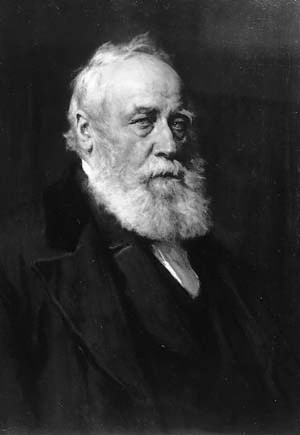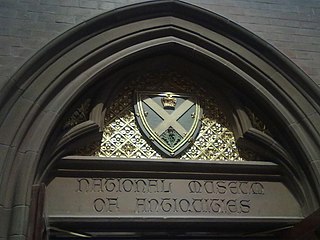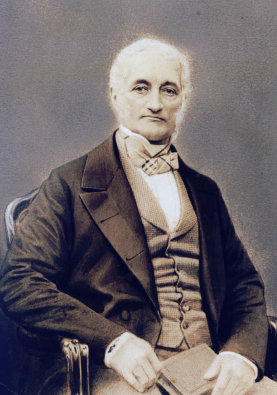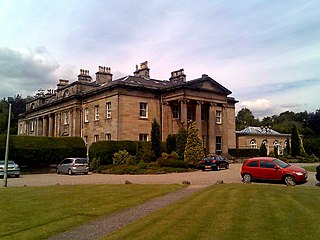
The Dean Cemetery is a historically important Victorian cemetery north of the Dean Village, west of Edinburgh city centre, in Scotland. It lies between Queensferry Road and the Water of Leith, bounded on its east side by Dean Path and on its west by the Dean Gallery. A 20th-century extension lies detached from the main cemetery to the north of Ravelston Terrace. The main cemetery is accessible through the main gate on its east side, through a "grace and favour" access door from the grounds of Dean Gallery and from Ravelston Terrace. The modern extension is only accessible at the junction of Dean Path and Queensferry Road.

William Forbes Skene WS FRSE FSA(Scot) DCL LLD, was a Scottish lawyer, historian and antiquary.

The Society of Antiquaries of Scotland is the senior antiquarian body of Scotland, with its headquarters in the National Museum of Scotland, Chambers Street, Edinburgh. The Society's aim is to promote the cultural heritage of Scotland.

William Burn was a Scottish architect. He received major commissions from the age of 20 until his death at 81. He built in many styles and was a pioneer of the Scottish Baronial Revival, often referred to as the golden age of Scottish architecture.

David BryceFRSE FRIBA RSA was a Scottish architect.

Alexander Seton, 1st Earl of Dunfermline (1555–1622) was a Scottish lawyer, judge and politician. He served as Lord President of the Court of Session from 1598 to 1604, Lord Chancellor of Scotland from 1604 to 1622 and as a Lord High Commissioner to the Parliament of Scotland.

Clan Drummond is a Highland Scottish clan. The surname is rendered "Druimeanach" in modern Scottish Gaelic.

Henry Home-Drummond FRSE FSA was a Scottish advocate, landowner, agricultural improver, and politician.

The Barony of Ladyland was in the old feudal Baillerie of Cunninghame, near Kilbirnie in what is now North Ayrshire, Scotland.

Greyfriars Kirkyard is the graveyard surrounding Greyfriars Kirk in Edinburgh, Scotland. It is located at the southern edge of the Old Town, adjacent to George Heriot's School. Burials have been taking place since the late 16th century, and a number of notable Edinburgh residents are interred at Greyfriars. The Kirkyard is operated by City of Edinburgh Council in liaison with a charitable trust, which is linked to but separate from the church. The Kirkyard and its monuments are protected as a category A listed building.

Sir Arthur Mitchell MD LLD was a Scottish doctor involved in the study and care of patients with mental illness. He served on several public commissions, and wrote widely on history and anthropology.
John Stuart LLD (1813–1877) was a Scottish genealogist.

Thomas Graham Balfour was a Scottish physician noted for his work with medical statistics, and a member of Florence Nightingale's inner circle.
George Drummond may refer to:

Richard Crichton was a Scottish architect operating in the late 18th and early 19th centuries. He was described as "competent and versatile".

Hugh Macmillan FRSE FSA (1833-1903) was a Scottish minister of the Free Church of Scotland who served as their Moderator of the General Assembly in 1897. He was a prolific author on theological subjects and the relationship between God and Nature. His most popular book Bible Teachings in Nature ran to 15 editions in both UK and USA and translated into several languages.
John Ramsay of Ochtertyre FRSE FSAScot (1736–1814) was a Scottish writer and antiquarian. A renowned letter-writer even in his own lifetime, most of his extensive correspondence has since been lost. His home in Stirlingshire is near Blair Drummond, in the parish of Kincardine-in-Menteith. Sometimes referred to as Oughtertyre or Auchtertyre, it is not to be confused by the larger Ochtertyre estate in Perthshire, owned by the Murray family.
Charles Rogers (1825–1890) was a 19th-century Scottish minister and prolific author. In the second half of his life, he repeatedly ran into trouble for setting up publication societies from which he gained financial benefit.
John Blair was a Scottish painter, predominantly of watercolour landscapes. Of humble beginnings in Berwickshire, he moved to Edinburgh to study and spent the rest of his life there. His paintings mainly reflect the landscapes around him, both of urban settings and also of the castles, sea and lochs of the Borders, although he also painted figures and still lifes. As well as his original work, his paintings were viewed by a wide audience in the form of picture postcards, book endpapers and illustrations.
Adam Erskine, Commendator of Cambuskenneth, was a Scottish landowner and courtier.














